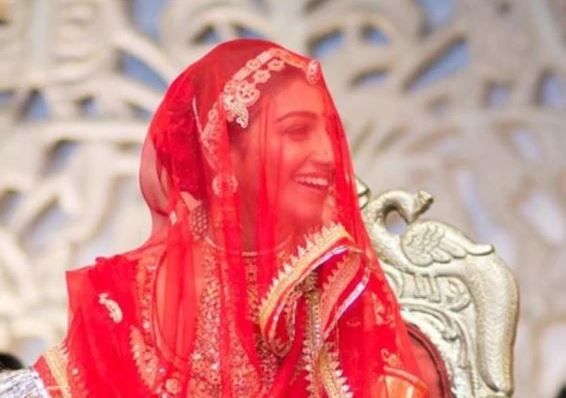prasad1
Active member
This topic may not be relevant to Tamil Brahmins but is important in the rest of India.
It is in GD section so be aware of the sensitivity of the topic.
 Mohena Kumari Singh /Instagram
Mohena Kumari Singh /Instagram
New Delhi: ‘Yeh Rishta Kya Kehlata Hai’ actress Mohena Kumari Singh, who recently got married to Suyesh Rawat, sparked a long-standing debate on Thursday about the traditional practice of ‘ghoonghat’ after she posted photos of her face hiding in a veil.
‘Why is your face under veil? questioned many, to which the actress proudly invoked her ‘Rajput’ tradition and asserted her ‘choice’. Respect each other’s culture, she schooled her trolls, for which she was hailed on social media.
But, if respecting culture means stripping women of their agency and further enabling patriarchy, then we are not on-board with it. Besides, we can’t negate that women’s so-called ‘choice’ in this sense is manipulated by centuries of social conditioning. As they say, choice is rarely ‘black or white’, maybe it holds completely true in this regard. More so, what does choice even mean when we live in a patriarchy? A facade, simply.
The practice of covering the head, especially by the bride during her wedding in almost all cultures, is universal. And surprisingly, just like Mohena, women don’t bat an eyelid, because since childhood, they are conditioned into believing that this practice is a part of womanhood.
Patriarchal control operates in dangerous ways and corrupts everyone, including women, lest we forget.
Be it a ‘ghoonghat’, or a ‘burqa’, cultures across the world continue to uphold these regressive practices in the name of protecting female modesty and decorum.
In January 2018, a survey revealed that a whopping 98 per cent women in rural Rajasthan, 90 per cent in urban Rajasthan, and 91 per cent in rural Uttar Pradesh, and 90 per cent in urban Uttar Pradesh practice ghunghat.
But it’s high time, that this toxicity in the name of culture and religion, needs to go! We need to ask why it is that only women are the torchbearers of Indian culture and everything holy?
In a post-liberalization era, where women today are shaping the world as it is, participating in a practice that positions them as being subservient to men just seems highly contradictory. If stripping away of the veil means the collapse of the social fabric and culture, so be it!

 www.india.com
www.india.com
It is in GD section so be aware of the sensitivity of the topic.

New Delhi: ‘Yeh Rishta Kya Kehlata Hai’ actress Mohena Kumari Singh, who recently got married to Suyesh Rawat, sparked a long-standing debate on Thursday about the traditional practice of ‘ghoonghat’ after she posted photos of her face hiding in a veil.
‘Why is your face under veil? questioned many, to which the actress proudly invoked her ‘Rajput’ tradition and asserted her ‘choice’. Respect each other’s culture, she schooled her trolls, for which she was hailed on social media.
But, if respecting culture means stripping women of their agency and further enabling patriarchy, then we are not on-board with it. Besides, we can’t negate that women’s so-called ‘choice’ in this sense is manipulated by centuries of social conditioning. As they say, choice is rarely ‘black or white’, maybe it holds completely true in this regard. More so, what does choice even mean when we live in a patriarchy? A facade, simply.
The practice of covering the head, especially by the bride during her wedding in almost all cultures, is universal. And surprisingly, just like Mohena, women don’t bat an eyelid, because since childhood, they are conditioned into believing that this practice is a part of womanhood.
Patriarchal control operates in dangerous ways and corrupts everyone, including women, lest we forget.
Be it a ‘ghoonghat’, or a ‘burqa’, cultures across the world continue to uphold these regressive practices in the name of protecting female modesty and decorum.
In January 2018, a survey revealed that a whopping 98 per cent women in rural Rajasthan, 90 per cent in urban Rajasthan, and 91 per cent in rural Uttar Pradesh, and 90 per cent in urban Uttar Pradesh practice ghunghat.
But it’s high time, that this toxicity in the name of culture and religion, needs to go! We need to ask why it is that only women are the torchbearers of Indian culture and everything holy?
In a post-liberalization era, where women today are shaping the world as it is, participating in a practice that positions them as being subservient to men just seems highly contradictory. If stripping away of the veil means the collapse of the social fabric and culture, so be it!

Behind the Veil: Whether it's A Choice or Compulsion, the Practice of 'Ghoonghat' Needs to Go
In a post-liberalization era, where women today are shaping the world as it is, participating in a practice that positions them being subservient to men just seems highly contradictory.
 www.india.com
www.india.com
